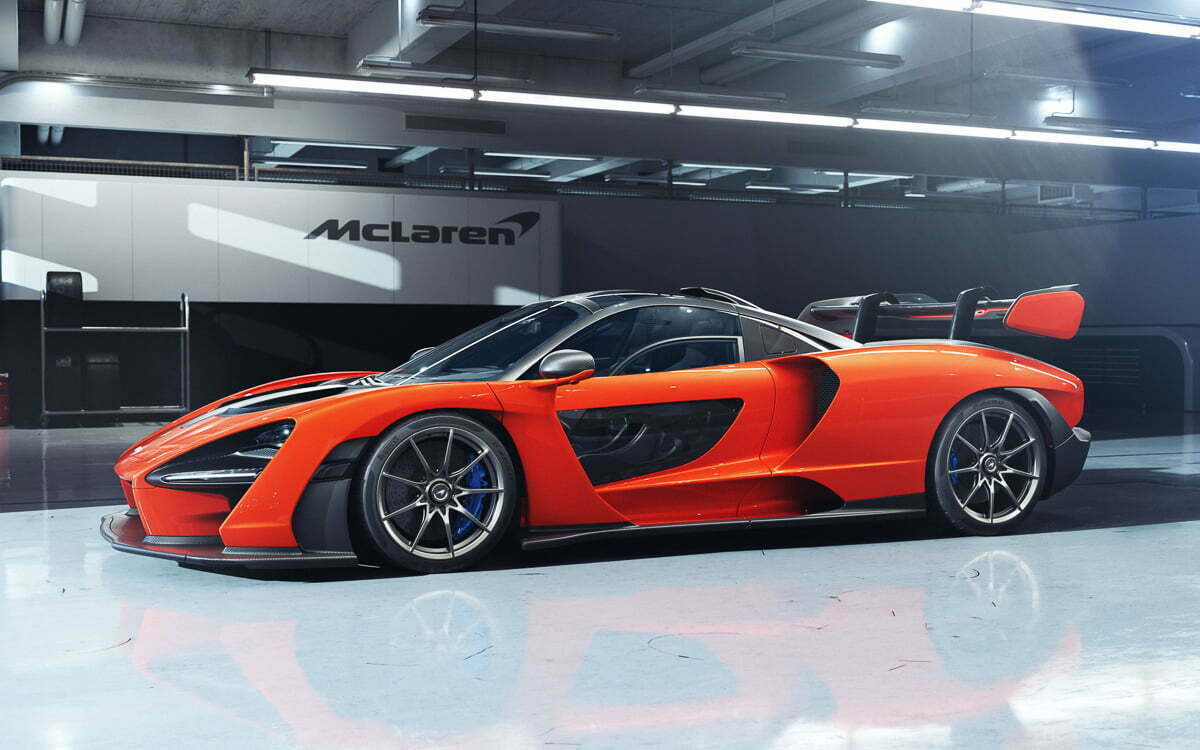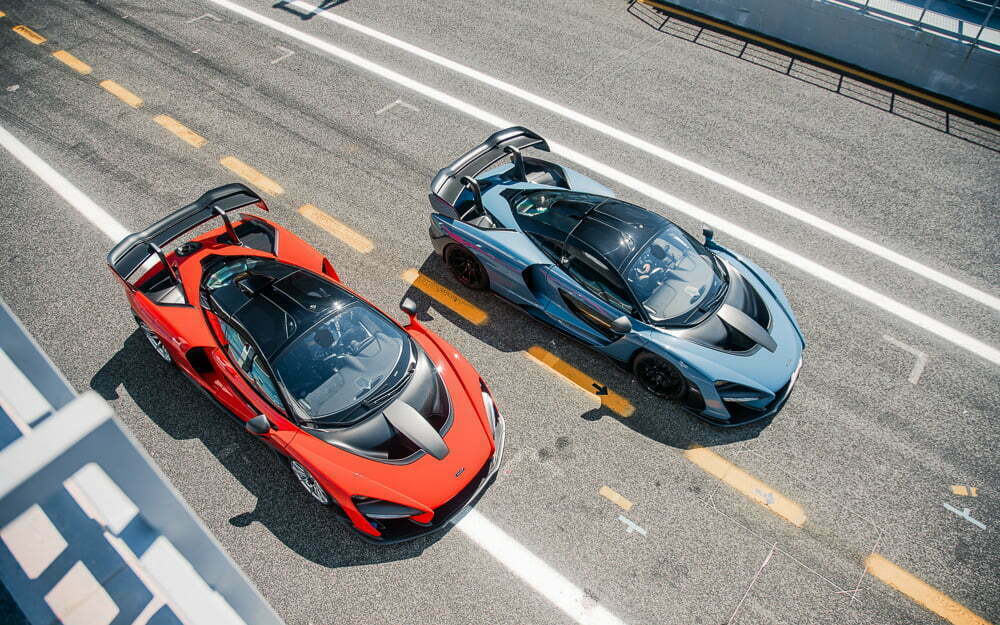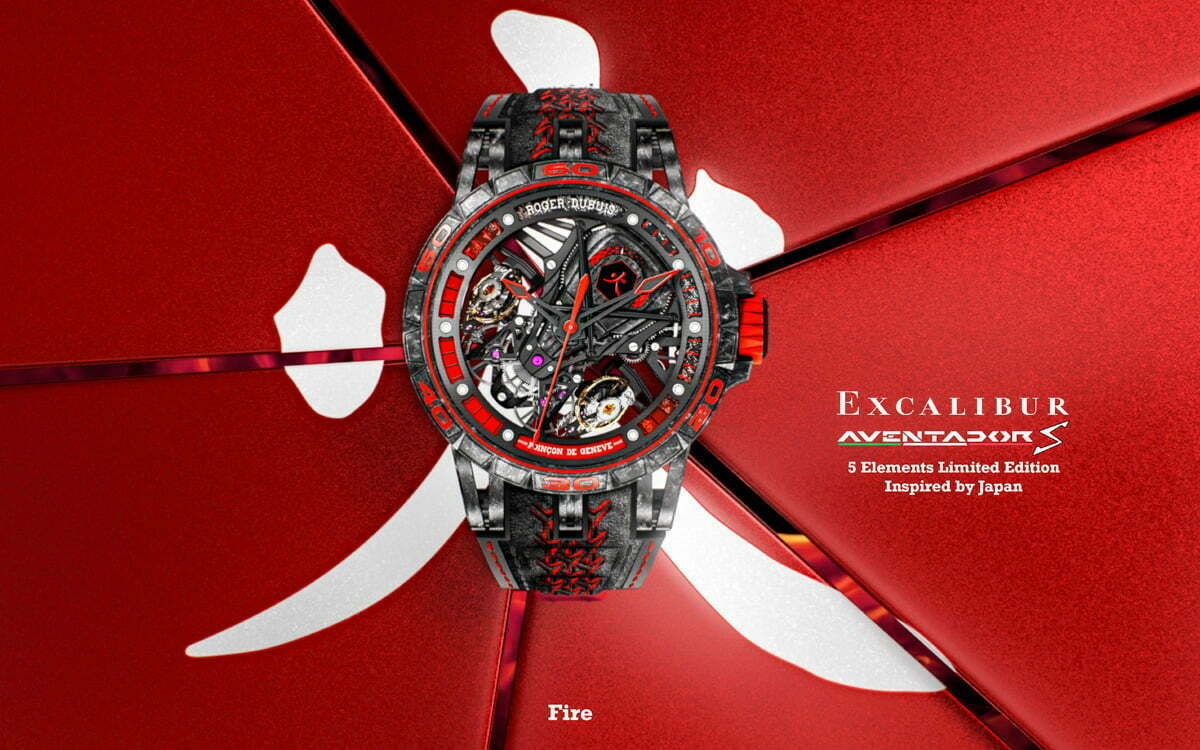
Andre Lam Drives The McLaren Senna In Estoril, Portugal
This car only uses a powerful albeit turbocharged internal combustion 800 hp V8 engine, weighs less than 1.2 tons and has superb aerodynamics that can develop 800 kg of downforce at just 250 km/h. It is lighter than the 720S (1238 kg) and P1 (1395 kg) but it is not as light as the original F1 (1138 kg) but that is only because of the many mandatory safety items like airbags and frontal and side impact requirements since 1993.
To get to a dry weight of 1198kg required extensive design and engineering. So extreme has been the use of carbon fibre that the front fender weighs just 0.66 kg (660gm) and the huge wing at the back that is capable to generating nearly half of the 800 kg of downforce weighs an unbelievable 4.87 kg! Even the entire Monocage III carbonfibre tub weighs just 94.5 kg. Each of the iconic dihedral doors are just 9.88 kg unpainted and a bit more if you specify the option of viewing glass below the beltline. Even the seat shell weighs a paltry 3.35 kg.
Aerodynamic downforce being the operative word meant the use of external wings, blades and extended splitters take precedent over the styling integrity. It may not be the sexiest McLaren but it certainly looks the wildest. Up to 60% of the downforce is generated by the design of the car’s underbelly and the rest is down to the front splitter and the rear hung wing. Because the wing is hung and not propped up as is the usual practice the airflow is cleaner by up to 30% on the more important surface which is the underside of the wing that generates the downforce rather than the top surface. The aerodynamicists have introduced a secondary louvred wing across the large wing’s trailing edge to capitalize on the rapid airflow coming off the wing’s top surface.
There are active elements that can increase downforce or lower downforce to reduce drag just like the DRS systems in F1 cars. The reason for this is the aero package which is so effective at generating downforce that it is capable of exceeding the quoted figure of 800 kg when speeds are in excess of 250 km/h. This will overload the tyres and suspension system so the downforce needs to be bled off to maintain 800 kg. The active aerodynamics also play a part during braking and to trim front to rear balance of downforce and handling.
More downforce equals more drag and a good portion of the 800 hp is used up to create downforce. The slippery shape of the McLaren F1 with just 610 hp helped it reach 391 km/h because its job then was primarily to set a world record for fastest production car. The Senna is not seeking to set any top speed records, instead it is going to try to be the fastest production track car there is. For the vast majority of race circuits it is difficult to exceed 300 km/h in a street-legal car so a V-max of 335 km/h might be sufficient headroom for the majority of tracks.
Having decided on the top speed makes it easier for the engineers to pack all that tremendous firepower into the space of 0-335 km/h which means all the 7-speeds of the SSG can be better optimised to deliver maximum acceleration up to 335 km/h instead of having to spread it thinly in order to achieve 400 km/h. Downforce acting on the bespoke P-Zero Corsa Trofeos help generate over 2g in cornering or braking which translates into higher cornering speeds and later braking points which help the car reach higher terminal speeds before turning in. That is the theory and on the charts that McLaren was showing us just before ushering us to get changed for the track session.
So with the full Nomex suit and undergarments complete with full face helmet plus HANS device in 28 degree weather is not just intimidating but downright uncomfortable. But the clock is ticking and McLaren wants us to get into the warm-up cars which were a bevy of 720Ss. We had as our coach/minder/instructor/passenger a bunch of pro-drivers, some fresh from the previous night of racing at the 24hours of LeMans race. They would let us know when to brake and how hard to push.
It is a good thing their nerves are a lot more settled than mine. We were given just four laps warm up in the 720S and were were expected to jump into the awaiting Senna and get it on. No pressure then. The 720S is no slouch around Estoril and it already was demanding. With professional drivers in the Senna it is a full 6 seconds faster than the 720S. How much faster could we be in the Senna?
We had 12 laps in the Senna over two sessions. You could say the first 3 laps were messy and very much exploratory before getting to grips with its vast capabilities. First difficulty was to trust the brakes at the end of the straight where we were braking from over 280 km/h for a second gear corner. It is almost unbelievable just how hard one can to brake to exceed 2g, literally standing on the pedal with all one’s might. The other surprise is how much braking grip was available and just how effective the ABS is.
The Senna is sensational as the front tyres never seem to run wide. The handling balance in the high and medium speed corners is neutral. It is brilliant when braking and turning in showing huge reserves. We did not try the Comfort or Sport modes just straight to Race mode. This apparently operates with a looser setting allowing some sideways action. Power oversteer is always just a twitch of the right foot away so circumspect is the order of the day but it is very clearly communicated through the chassis and steering. The chassis responds so positively one’s actions or even reactions.
At the end of the first session the sheer physicality is taking its toll or maybe its just the heat. It is good we had the second session after we have rested and collected our thoughts. How the car could brake so unbelievably late and how the huge 390mm Carbon Ceramic brakes could take all that punishment and not wilt one bit. The tyres never overheated and always turned in and the pro-drivers would calmly sit in the passenger seat and trust us to somehow get it right and not leave the track inadvertently.
This is good news for the buyers of the Senna because all the guesswork of setting up a car perfectly for the track has been done by McLaren. Even a so called performance car in its road going form is unsuitable for the track. Sometimes it needs track tyres or race brake pads or special suspension geometry. None of that is necessary for the Senna. It is pretty much perfect for most tracks right out of the box.
Rested and collected the second session proved much smoother and we were able to better utilize the aerodynamic downforce in the corners using the experience garnered from the first session. The Senna in the right hands is quite simply amazing. It is almost unbelievable how a car this capable can allow me, an experienced but far from professional driver to drive it so hard and fluidly like I would a 720S. I fully understand the safety requirements for the track suit and helmet but that was a real hindrance to the full enjoyment of just driving the Senna when not in full-attack mode. A pity because the Senna is built to allow full communication with the car as if we could meld with the machine and become one.
They have kept the hydraulic power steering set up and not gone with electric power assist which robs the steering of so much feel. Theirs is a hybrid electro-hydraulic set up meaning instead of driving the hydraulics off the engine, it has an electric motor. Perhaps it’s the best of both worlds. The throttle response despite being turbocharged is well metered and linear during mid corner where delicacy in power delivery is important in order not to upset the car’s balance.
The sophisticated cross-linked hydraulic suspension does all that a conventional spring-damper system can do and more. It successfully counters body roll and pitch without roll bars or conventional springs. Curiously there are some springs but those are only meant as helper springs to maintain static height when the hydraulics are shut down. Amazingly the hydraulic suspension can lower itself in race mode by 39mm to improve stability and increase the ground effects resulting in better downforce from the underside of the car. Also it maintains ride height as the downforce increases to 800 kg at 250 km/h.
Unfortunately there was no road drive so we can only guess at its road behaviour. McLaren’s sophisticated hydraulic suspension has been surprisingly comfortable when one considers its considerable roll and pitch resistance. There is even air-conditioning which is a good thing and only a handful were ordered without it.
Could the Senna be more extreme? Of course but it then might not be street-legal. As it is the Senna can be registered in almost every country except China. But that is not a problem for sales as we understand that all 500 of the limited production run have been allocated. It is curious then as to why I was invited to a car launch that is already unavailable for sale. Perhaps what is allocated does not mean sold out. There are some dealerships who have taken allocation but have yet to actually find an owner or might be persuaded to part with their allocated Senna for a price.
Whatever the reason I for one am glad that I had the chance to sample what might be true automotive nirvana. It is almost unbelievable how a race-spec car can allow me to drive it so hard and fluidly like I would a 720S. The only hardship seems to be the 5-point harness and its price tag of nearly US$1m before taxes but congratulations if you have the finances because this is one of the true greats in the automobile world plus it comes with one of the the most evocative names of all time.
Photos: McLaren Press








































